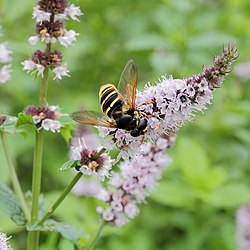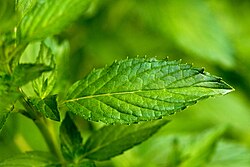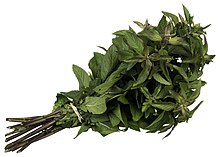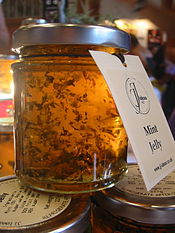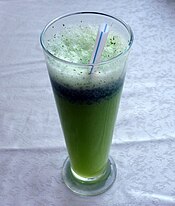
Peppermint is a hybrid species of mint, a cross between watermint and spearmint. Indigenous to Europe and the Middle East, the plant is now widely spread and cultivated in many regions of the world. It is occasionally found in the wild with its parent species.

Spearmint, a species of mint (mentha) scientifically classified as Mentha spicata (,) also known as garden mint, common mint, lamb mint and mackerel mint, is native to Europe and southern temperate Asia, extending from Ireland in the west to southern China in the east. It is naturalized in many other temperate parts of the world, including northern and southern Africa, North America, and South America. It is used as a flavouring in food and herbal teas. The aromatic oil, called oil of spearmint, is also used as a flavoring and sometimes as a scent.

Mentha pulegium, commonly (European) pennyroyal, or pennyrile, also called mosquito plant and pudding grass, is a species of flowering plant in the mint family, Lamiaceae, native to Europe, North Africa, and the Middle East. Crushed pennyroyal leaves emit a very strong fragrance similar to spearmint. Pennyroyal is a traditional folk remedy, emmenagogue, abortifacient, and culinary herb, but is toxic to the liver and has caused some deaths. European pennyroyal is related to an American species, Hedeoma pulegioides. Though they differ in genera, they share similar chemical properties.

Mentha aquatica is a perennial flowering plant in the mint family Lamiaceae. It grows in moist places and is native to much of Europe, northwest Africa and southwest Asia.
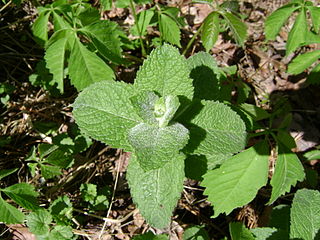
Mentha suaveolens, the apple mint, pineapple mint, woolly mint or round-leafed mint, is a member of the mint family Lamiaceae. It is native to southern and western Europe including the Mediterranean region. It is a herbaceous, upright perennial plant that is most commonly grown as a culinary herb or for ground cover.

Mentha longifolia, also known as horse mint, brookmint, fillymint or St. John's horsemint, is a species of plant in the family Lamiaceae. It is native to Europe excluding Britain and Ireland, western and central Asia, and northern and southern Africa.
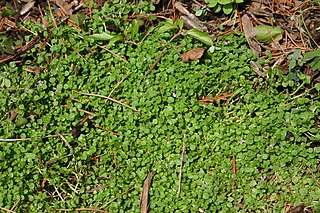
Mentha requienii, or Corsican mint, is an herb and species of mint, native to Corsica, Sardinia, and Montecristo Island, and naturalized in Portugal and in the British Isles. It is a very low-growing species with bright green leaves and a strong minty aroma.

Pulegone is a naturally occurring organic compound obtained from the essential oils of a variety of plants such as Nepeta cataria (catnip), Mentha piperita, and pennyroyal. It is classified as a monoterpene.

Monardella is a genus of approximately 40 species of annual and perennial plants native to western North America from British Columbia to northwestern Mexico. They are grown for their highly aromatic foliage, which in some species is used for herbal teas. The two-lipped, tubular flowers are formed in terminal clusters and are most usually red, pink, or purple.

Mentha arvensis, the corn mint, field mint, or wild mint, is a species of flowering plant in the mint family Lamiaceae. It has a circumboreal distribution, being native to the temperate regions of Europe and western and central Asia, east to the Himalaya and eastern Siberia, and North America. Mentha canadensis, the related species, is also included in Mentha arvensis by some authors as two varieties, M. arvensis var. glabrata Fernald and M. arvensis var. piperascens Malinv. ex L. H. Bailey.

Eau de Cologne mint, also known as orange mint and bergamot mint, is a cultivated mint. In a 1970 study, most plants were found to be male sterile forms of Mentha aquatica, so were regarded as Mentha aquatica var. citrata, although in England the hybrid Mentha × piperita was found. The Royal Horticultural Society treats eau de Cologne mint as Mentha × piperita f. citrata. The World Checklist of Selected Plant Families sinks both scientific names into Mentha aquatica.

Mentha canadensis is a species of mint native to North America and the eastern part of Asia. In North America, it is commonly known as Canada mint, American wild mint, and in Asia as Chinese mint, Sakhalin mint, Japanese mint, and East Asian wild mint. The flowers are bluish or have a slight violet tint. The plant is upright, growing to about 4–18 in (10–46 cm) tall. Leaves grow opposite from each other, and flower bunches appear in the upper leaf axils. The mint grows in wet areas but not directly in water, so it will be found near sloughs, and lake and river edges. Plants bloom from July to August in their native habitats.
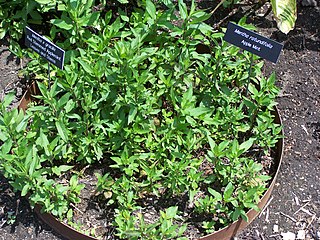
Mentha × gracilis is a hybrid mint species within the genus Mentha, a sterile hybrid between Mentha arvensis (cornmint) and Mentha spicata. It is cultivated for its essential oil, used to flavour spearmint chewing gum. It is known by the common names of gingermint, redmint and Scotchmint in Europe, and as Scotch spearmint in North America.

Mentha cervina, commonly known as hart's pennyroyal, is a perennial herbaceous plant of the Mentha (mint) genus. It is native to the western Mediterranean Sea region, growing naturally from southwestern France to the Iberian Peninsula, and south to Azores, Morocco and Algeria. Its common name reflects a traditional association with the separate species Mentha pulegium or pennyroyal. The plants were associated due to their shared high pulegone content, which gives them both a distinctive, strong aroma.
Apple mint is a common name for Mentha suaveolens, and hybrid mints involving M. suaveolens as a parent

Cassida viridis, common name green tortoise beetle, is a species of beetle in the leaf beetle family (Chrysomelidae).
Mentha japonica is a plant species in the genus Mentha, endemic to the islands of Hokkaido and Honshu, Japan. Initially described as Micromeria japonica by Friedrich Anton Wilhelm Miquel, it was first identified under its present name by Japanese botanist Tomitaro Makino in 1906. A relatively rare plant, it is classified by the Japanese Ministry of Environment as a Near Threatened species.
Mentha grandiflora is a plant species in the genus Mentha, endemic to eastern Australia. The species was described in 1848 by botanist George Bentham. Its epithet, grandiflora, means "with large flowers".

Mentha x villosa is a hybrid species of mint, a cross between Mentha spicata and Mentha suaveolens.
